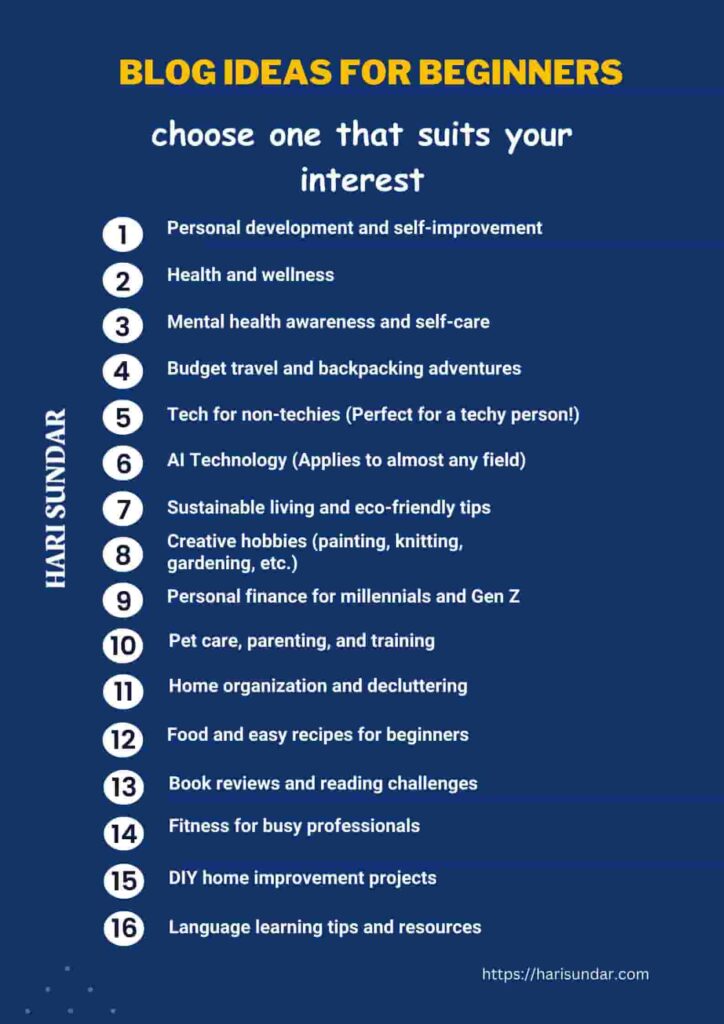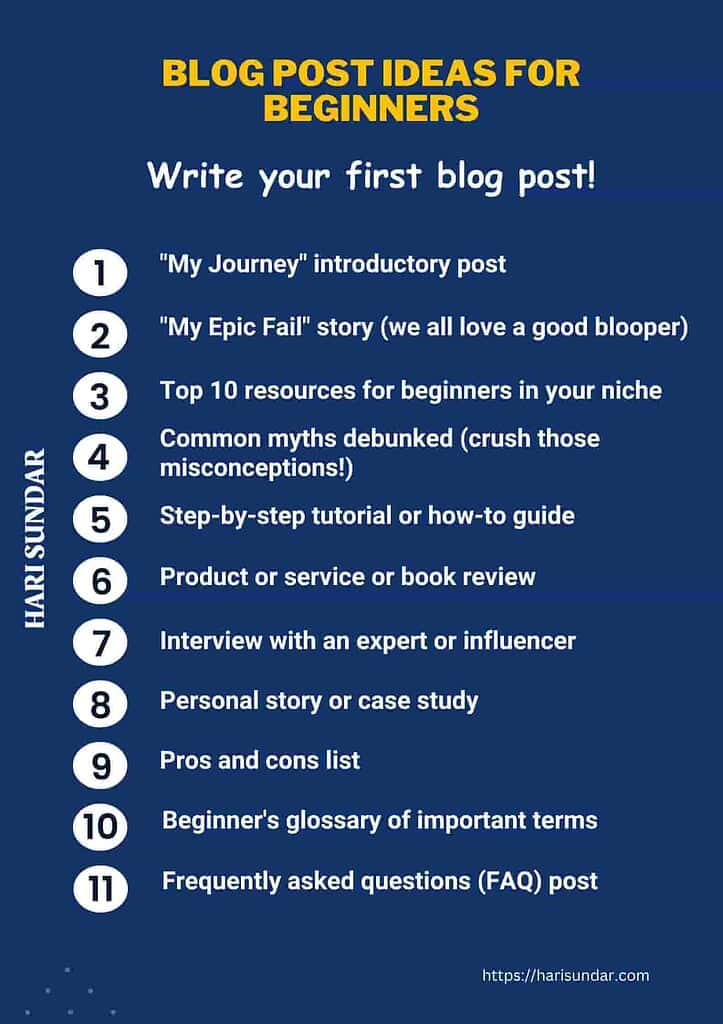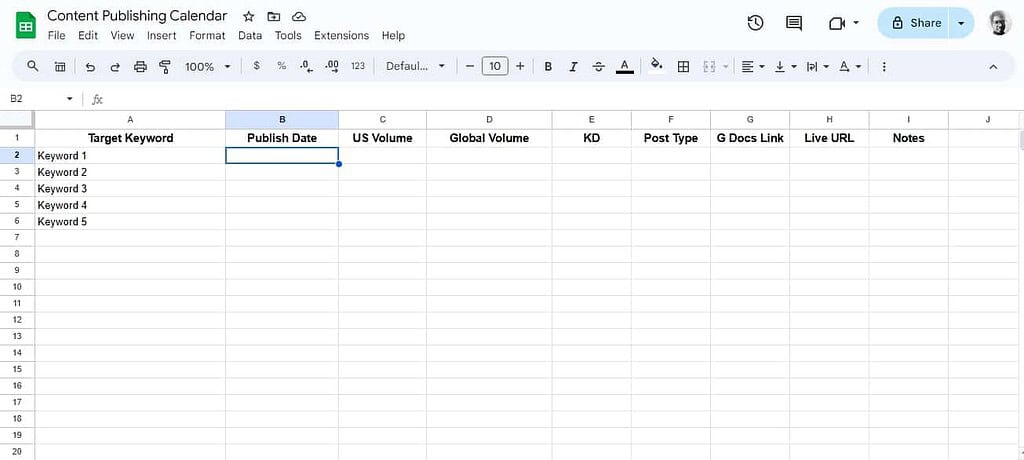15+ Blog Ideas for Beginners: Niche Domination Guide 2024

Ever stared at a blank screen, wondering what the heck to blog about? Been there, done that! When I started in 2019, I wrote about everything from wellness to science explaining what a zero-watt bulb is.
I wish I had known how to start a blog properly from the beginning. It would have saved me a lot of time and effort.
But here’s the kicker – 60% of internet users read blogs regularly. That’s a huge audience waiting for your unique take on things!
Whether you’re itching to share your passion or looking to make some extra cash through affiliate marketing, I’ve got you covered.
Here’s what we are going to cover: Your Roadmap to Blogging Success
- Discover 15+ fresh blog ideas perfect for beginners
- Learn how to choose your ideal blogging niche
- Get 11 versatile blog post ideas that work for any topic
- Master 5 essential tips to set up your blog for success
- Find answers to common beginner blogging questions
From personal blogs to business blog ideas, we’ll cover various topics to get your creative juices flowing. Ready to turn that blank screen into your personal goldmine?
Let’s dive into these blog ideas for beginners and kickstart your blogging journey!
Finding Your Blogging Sweet Spot: 15+ Niche Ideas to Explore
Choosing the right niche is crucial for blogging success. It’s the foundation that’ll shape your content, audience, and potential income. Let’s explore 15+ blog topic ideas to get you started:

1. Personal development and self-improvement
This niche focuses on helping people become their best selves.
You could write about:
- Goal-setting,
- Productivity hacks, or
- Overcoming self-doubt.
Share your growth journey and the techniques that worked for you. Use tools like Trello for goal tracking or recommend books like “Atomic Habits” by James Clear.
Authenticity is key – readers connect with real stories and practical advice. Consider creating a 30-day challenge for your readers, tracking their progress through a specific self-improvement goal.
This can boost engagement and provide valuable content ideas. Remember to address common obstacles in personal growth and offer actionable solutions.
2. Health and wellness
Instead of generic health tips, focus on a unique angle. Maybe it’s wellness for night owls or health hacks for busy parents.
Start by researching common health issues in your target audience. Use platforms like Pinterest to find trending wellness topics.
Don’t forget to include disclaimers and cite reputable sources for any health claims. You could create a series on unconventional health practices from around the world, or explore the intersection of technology and wellness.
Consider partnering with nutritionists or fitness experts for guest posts to add credibility to your content. Always emphasize the importance of consulting healthcare professionals before making significant lifestyle changes.
3. Mental health awareness and self-care
This important niche addresses the growing need for mental health resources. Share coping strategies, mindfulness techniques, or reviews of therapy apps.
Collaborate with mental health professionals for expert insights. Use tools like Headspace or Calm to guide readers through meditation exercises.
Always approach this topic with sensitivity and encourage professional help when needed. Consider creating a weekly “Mental Health Check-In” series where you discuss different aspects of mental well-being.
You could also explore the impact of social media on mental health or share stories of mental health journeys (with permission) to reduce stigma and inspire others.
4. Budget travel blogs and backpacking adventures
Perfect for someone who loves to travel on a shoestring budget. Share money-saving travel hacks, budget destination guides, or packing tips.
Use your own travel experiences as a starting point. Tools like Skyscanner or Hostelworld can help readers plan affordable trips.
Don’t forget to include stunning photos to inspire your audience’s wanderlust. Create a series on “Hidden Gems” in popular destinations that are often overlooked by tourists.
You can also focus on sustainable travel practices or how to travel on a weekend warrior schedule. Consider creating printable packing lists or budget trackers for your readers.
If you have experience in traveling and all the related things, don’t wait for anything to start a travel blog, your audience is waiting!
5. Tech for non-techies (Perfect for a techy person!)
Simplify complex tech concepts for the average user. Write beginner-friendly tutorials on setting up smart home devices or choosing the right laptop. Use analogies to explain tech jargon.
Use Canva to create easy-to-follow visual infographic guides. Remember, your goal is to make tech less intimidating for your readers.
Consider creating a “Tech Term of the Week” series to gradually build your readers’ tech vocabulary.
Review tech gadgets and write comparison posts of popular tech products, explaining the differences in simple terms.
Don’t forget to cover internet safety and privacy topics to help your readers navigate the digital world securely.
6. AI Technology (Applies to almost any field)
AI is booming like the dot.com boom we had seen before. Demystify AI for the masses. Explain how AI impacts daily life, from smartphone features to job markets.
Use real-world examples, like how Netflix uses AI for recommendations. Stay updated with AI news from sources like MIT Technology Review. There are plenty of topics you can write about from AI in healthcare to AI in marketing.
Create simple infographics to visualize complex AI concepts. You could start an “AI in Your Life” series, highlighting everyday AI applications people might not recognize.
Consider exploring ethical considerations in AI development or how AI is changing different industries. Don’t shy away from discussing potential drawbacks or challenges of AI to provide a balanced view.
7. Sustainable living and eco-friendly tips
Help readers reduce their carbon footprint with practical tips. Cover topics like zero-waste living, eco-friendly product reviews, or sustainable fashion.
Share your journey towards a greener lifestyle. Use tools like the WWF Footprint Calculator to help readers assess their impact.
Partner with eco-friendly brands for product reviews or affiliate opportunities. Create a challenge for readers to adopt one new sustainable habit each month. You could also focus on budget-friendly eco tips or how to make existing products more sustainable.
Consider discussing larger environmental issues and how individual actions can make a difference.
8. Creative hobbies (painting, knitting, gardening, etc.)
Choose a specific hobby or cover multiple creative pursuits. Offer beginner tutorials, supply recommendations, or showcase reader projects. Use video platforms like YouTube to demonstrate techniques.
For gardening, apps like PlantNet can help readers identify plants. Encourage readers to share their creations, building a community around your blog.
Start a monthly creative challenge, providing a theme and showcasing submissions. Consider exploring the mental health benefits of creative hobbies or how to turn a hobby into a side hustle. Don’t forget to cover common mistakes beginners make and how to avoid them.
9. Personal finance for Millennials and Gen Z
Break down complex financial concepts for young adults. Cover topics like budgeting apps, investing basics, or paying off student loans.
Use your financial wins (and mistakes) as teaching moments. Recommend tools like Mint or YNAB for budgeting.
Always include disclaimers about seeking professional financial advice. Create a series on “Financial Firsts” – first job, first apartment, first investment, etc.
Consider discussing the gig economy and how to manage finances with inconsistent income. You could also explore topics like the psychology of spending or how to discuss money with partners and friends.
10. Pet care, parenting, and training
Share tips on raising happy, healthy pets. Cover topics like nutrition, behavior training, or choosing the right pet. Use your own pet parenting experiences as a foundation.
Partner with local vets or trainers for expert advice. Tools like the Puppr app can help with dog training tutorials. Don’t forget to include adorable pet photos to engage your audience.
Create a “Pet of the Month” feature to showcase your readers’ furry friends. Consider discussing pet health insurance, DIY pet toys, or how to travel with pets. Start exploring topics like adopting vs. buying pets or how to introduce new pets to a household.
11. Home organization and decluttering
Help readers create harmonious living spaces. Share organization hacks, minimalism tips, or room-by-room decluttering guides.
Use before-and-after photos of your organizing projects. Recommend tools like the KonMari app or Home Edit labels.
Create printable checklists to help readers tackle their clutter. Start a “15-Minute Declutter Challenge” series with quick, actionable tasks.
Consider discussing the psychology behind clutter or how to organize on a budget. You could also explore topics like digital decluttering or how to organize for different life stages (college, first apartment, family home, etc.).
12. Food and easy recipes for beginners
Focus on simple, delicious recipes for kitchen novices. Share step-by-step cooking tutorials, ingredient substitution guides, or budget meal plans. Use your own cooking mishaps as learning opportunities.
Create short recipe videos for platforms like TikTok or Instagram. Because incorporating videos for cooking is the best way to engage with your audience.
Recommend basic kitchen tools to help readers get started. Start a “Pantry Raid” series, creating meals from common household ingredients.
Cover topics like food safety, meal prepping for beginners, or how to read and understand food labels. You could also explore cuisines from different cultures, focusing on accessible recipes for beginners.
13. Book reviews and reading challenges (I love reading books and you?)
Share your love of literature with fellow bookworms. Offer honest reviews, reading lists by genre, or host virtual book clubs. Use platforms like Goodreads to track your reading and connect with other bloggers.
Create themed reading challenges to engage your audience. Partner with indie bookstores for affiliate opportunities.
Start a “First Chapter Friday” series where you review the opening of a book. Consider discussing topics like how to fit reading into a busy schedule or the impact of bestseller lists on reading habits. You could also explore the world of audiobooks or how to start a neighborhood book exchange.
14. Fitness for busy professionals
Help time-strapped readers stay fit with efficient workouts and health tips. Share quick exercise routines, office-friendly stretches, or healthy meal prep ideas.
Use your own fitness journey as inspiration. Recommend apps like 7 Minute Workout or MyFitnessPal.
Always include proper form guidance and encourage readers to consult healthcare providers before starting new routines.
Create a “Desk Jockey Fitness” series with exercises that can be done at work. Consider discussing topics like how to stay motivated with fitness goals or the importance of rest and recovery. Talk about different fitness trends and their effectiveness for busy lifestyles.
15. DIY home improvement projects
Guide readers through simple home upgrades and repairs. Share step-by-step tutorials, tool guides, or budget renovation ideas.
Use your DIY successes (and failures) as content. Create detailed supply lists and time estimates for each project. Recommend apps like iHandy Carpenter for basic measurements.
Always include safety precautions in your tutorials. Start a “Weekend Warrior” series with projects that can be completed in 1-2 days.
Consider discussing topics like how to choose the right tools for beginners or how to estimate project costs accurately. You could also explore upcycling projects or how to prepare your home for different seasons.
16. Language learning tips and resources
Help aspiring polyglots master new languages. Share study techniques, app reviews, or cultural insights for popular languages. Use your language learning experiences as a guide.
Recommend tools like Duolingo or Anki for vocabulary practice. Create printable phrase sheets for common expressions in various languages.
Start a “Word of the Day” series in different languages, explaining usage and cultural context. Consider discussing topics like the benefits of bilingualism or how to maintain language skills without immersion.
You could also explore unconventional language learning methods or how to choose the right language to learn based on personal goals.
The key to a successful blog is consistently applying the right strategies. Now we’ll cover how to choose a niche you genuinely enjoy, and you’ll never run out of blog post ideas.
From Idea to Reality: How to Choose Your Niche
Struggling to pick the perfect blog niche? Let’s break down the process into five crucial steps to find your ideal blogging sweet spot.
1. Knowledge + Expertise = Your Blogging Sweet Spot
Finding your blog niche starts with a simple equation: your knowledge plus your expertise. Think about what you know well and what topics you can talk about.
Maybe you’re a whiz at budgeting or you can’t stop talking about mindfulness and productivity hacks. That’s your sweet spot!
For example, I started blogging on digital marketing, especially teaching blogging, SEO, and content marketing to my readers. As my expertise grows, I will expand to other areas of digital marketing in the future.
2. Research Market Demand and Competition
Once you’ve identified potential niches, it’s time to play detective. Use tools like Google Trends to see if people are interested in your topic.
Use keyword research tools such as Ahrefs and Semrush to identify potential keywords that you can write about.
Don’t be discouraged if there are other blogs in your niche – that means there’s an audience! Instead, look for gaps in their content that you could fill.
3. Show Me the Money: Evaluating Monetization Potential
Let’s talk cash, folks. Different niches have different monetization opportunities. Some, like personal finance or travel, naturally lend themselves to affiliate marketing and sponsorships.
Others, like hobby-based niches or physical products, might be better suited for affiliate marketing. If you love teaching stuff, and talking about topics for hours, then creating courses or digital products may be the better option.
4. Test the Waters with a Sub-Niche Strategy
Not sure if your chosen niche will work? Start small with a sub-niche. It’s like dipping your toes in the water before diving in.
If you’re interested in fitness, you might start with “15-minute workouts for busy professionals” instead of tackling the entire fitness industry.
This approach allows you to build expertise and an audience in a specific area before expanding. So, you will be the go-to source for your sub-niche and it increases topical authority.
5. Future-Proofing: Can You Talk About This Topic Forever?
Here’s a crucial question: will you still be excited about this topic a year from now? Two years? Five? Choose a niche that has staying power – both in terms of market interest and your expertise or experience.
In my case, the ever-evolving nature of digital marketing ensures I always have something new to write about. Plus, I genuinely enjoy explaining marketing, blogging, and SEO concepts, which keeps me motivated.
Remember, choosing your niche is just the first step in your blogging journey. It’s okay if you don’t get it perfect right away.
Many successful bloggers pivot or refine their niche as they grow. Creating content consistently is key to becoming a successful blogger in any niche.
The key is to start with something you’re knowledgeable about and have some expertise in and be willing to adapt based on your audience’s needs and your own evolving interests.
What to do: Take 5 minutes to list your top 3 areas of expertise and knowledge. These could be your perfect niches!”
Kickstart Your Content: 11 Killer Blog Post Ideas for Any Niche
Now that you’ve chosen your niche, what should you write about? Here are 11 versatile blog post ideas that work across any topic, helping you kickstart your blogging journey and keep your readers coming back for more.

1. “My Journey” introductory post
Share your story and why you’re passionate about your niche. This helps readers connect with you personally.
For example, if you’re blogging about fitness, talk about your health struggles and triumphs. Include milestones, setbacks, and lessons learned. Use this post to set expectations for your blog’s content and tone.
Pro tip: 65% of people are visual learners, so include highly engaging photos or a timeline infographic to illustrate your journey. End with your goals for the blog, inviting readers to join you on this adventure.
2. “My Epic Fail” story (we all love a good blooper)
Vulnerability builds trust. Share a major mistake you made in your niche and what you learned. For instance, if you’re a food blogger, describe a disastrous recipe experiment.
Be specific about what went wrong and why. Then, explain how you fixed it or what you’d do differently. Use humor to keep it light-hearted. Did you know that posts with a touch of self-deprecating humor can increase engagement by up to 25%?
Include tips for readers to avoid similar mistakes. This type of content shows you’re human and positions you as a relatable guide.
3. Top 10 resources for beginners in your niche
Curate a list of essential tools, websites, books, or apps for newcomers. If you’re a gardening blogger, you might include seed catalogs, plant identification apps, and reliable gardening websites.
Briefly explain why each resource is valuable and how to use it. Consider creating a downloadable PDF checklist for easy reference.
Interesting fact: Lists with odd numbers typically get 20% more clicks than even-numbered lists. So, you could make it a top 11 list for extra impact. Don’t forget to update this post regularly to keep it relevant.
4. Common myths debunked (crush those misconceptions!)
Every niche has its share of misinformation. Tackle popular myths head-on with facts and research. For a personal finance blog, you might debunk myths about credit scores or investing. Use compelling statistics to support your points.
For example, “Contrary to popular belief, checking your credit score doesn’t lower it. 77% of Americans don’t know this!” Include expert quotes to add credibility.
End each myth-busting section with the correct information and actionable advice. This type of post positions you as a trusted authority in your niche.
5. Step-by-step tutorial or how-to guide
Break down a complex process into easy-to-follow steps. If you’re a DIY blogger, you could guide readers through upcycling an old piece of furniture. Use clear, concise instructions with plenty of visuals.
Did you know that articles with images get 94% more views than those without? Include a list of required materials, estimated time, and difficulty level.
Anticipate common questions or stumbling points and address them proactively. End with a call to action asking readers to share their results or questions in the comments.
6. Product or service or book review
Offer an honest, in-depth review of something relevant to your niche. For a tech blog, you might review the latest smartphone or a popular productivity app. For a review post, you must discuss the pros, cons, and your personal experience.
Use a consistent rating system across all reviews for easy comparison. Include both subjective opinions and objective facts.
For example, “While I love the camera quality, benchmark tests show it’s 15% slower than its main competitor.” Don’t forget to disclose any affiliate relationships for transparency.
7. Interview with an expert or influencer
Reach out to a respected figure in your niche for an interview. This adds valuable insights and can help grow your audience.
For a writing blog post, you might interview a successful author about their process. Prepare thoughtful questions that your audience would want answered.
Include a mix of professional and personal questions to keep it engaging. Fun fact: Interviews are shared on social media 39% more often than other types of content. Consider offering the interview in multiple formats (text, video, podcast) to cater to different preferences.
8. Personal story or case study
Share a detailed account of how you (or someone else) achieved a specific goal in your niche. For a travel blog, you could describe how you planned and executed a budget trip to Europe.
Include specific strategies, challenges faced, and outcomes. Use data to back up your points – for instance, “By using these tactics, I saved 47% compared to the average tourist spend.”
Break the story into clear sections with subheadings for easy reading. End with key takeaways that readers can apply to their situations.
9. Pros and cons list
Create a balanced analysis of a topic, product, or decision relevant to your niche. If you’re a parenting blogger, you might discuss the pros and cons of different educational approaches.
Present each point clearly, explaining its impact. Use real-life examples or hypothetical scenarios to illustrate each pro and con.
80% of readers appreciate balanced content that presents multiple viewpoints. Consider using a table or infographic to visually represent the pros and cons.
Conclude with your overall recommendation, but encourage readers to weigh the factors based on their own situations.
10. Beginner’s glossary of important terms
Compile a list of essential terms and concepts in your niche. For a photography blog, you’d explain terms like aperture, ISO, and shutter speed.
Define each term simply, then provide a more detailed explanation with examples. Include visuals where possible – diagrams, charts, or example photos can help clarify complex ideas. For me, as a digital marketer, I teach SEO and blogging terms to my readers.
Blog posts with glossaries can reduce bounce rates by up to 30%. They give new readers a valuable reference point. Consider making this an evergreen post that you update regularly with new terms.
11. Frequently Asked Questions (FAQ) post
Address common queries your readers might have about your niche. If you’re a fitness blogger, you could answer questions about workout frequency, nutrition, or equipment.
Use actual questions from your audience or common Google searches in your niche. Provide concise yet comprehensive answers. Include links to related posts for more in-depth information.
FAQ posts can improve your SEO by targeting long-tail keywords naturally. Include a FAQ section at the end of each of your blog posts to increase the engagement rate.
Pick one idea and outline your first blog post right now!
Blogging Basics: 5 Tips to Set You Up for Success
Let’s cut through the noise and focus on what matters. These five tips will set you up for success, saving you time and headaches down the road.
1. Choose a user-friendly platform
WordPress.org is your best bet for beginners. It’s easy to use and has tons of features. I started with Blogger, but quickly realized its limitations. WordPress offers more flexibility and growth potential.
To get started:
- Pick your niche
- Get your hosting and domain
- Install WordPress
- Set up your blog and give it a name
- Select a theme and customize it
- Submit your site to Google Search Console and Google Analytics
- Start writing!
2. Pick a clean, responsive theme
A good theme makes your blog look professional and works well on all devices. I use the Kadence Theme for my blog. It is lightweight and easy to set up with Kadence AI.
Your theme specifications:
- Load quickly
- Mobile-friendly
- Have a clean, uncluttered design
- Offer customization options
3. Learn basic SEO principles
SEO isn’t just for tech geeks. Understanding the basics will help your blog posts get found. I wish I’d known this when I started – it would’ve saved me months of writing to crickets.
Key SEO tips:
- Use relevant keywords naturally in your content
- Write descriptive titles and meta-descriptions
- Use header tags (H1, H2, etc.) to structure your posts
- Interlink your blog posts
4. Create a content calendar
Consistency is key in blogging. I used to write randomly, which led to long gaps between posts and lost readers. Don’t repeat my mistake, a content calendar will save you more time and keep you on track.
To make a simple content calendar:
- Choose a tool (Google Sheets works great)
- Decide on a posting frequency (start with once a week, and gradually increase your publishing frequency)
- Brainstorm post ideas for the next month
- Assign dates to each post idea
Look at the screenshot below for an easy blog content calendar:

5. Engage with your audience
Blogging isn’t a one-way street. Respond to comments and share your posts on social media. Interact with your audience and create a like-minded community around your blog.
Engagement tips:
- Reply to every comment
- Ask questions in your posts to encourage discussion
- Share your posts on social media platforms where your audience hangs out
Remember, blogging is a journey. You should learn blogging the right way and improve as you go. The key is to start and keep at it.
Ready to start your blog? Get your hosting and domain name, set up your blog, and write your first post today!
Conclusion
Alright! You’ve now got a treasure trove of blog ideas to kick off your adventure. Remember, the key is to start – even if it’s not perfect. Trust me, I’ve been there, fumbled around, and learned a thing or two along the way.
Pick a niche that lights your fire, whether it’s a lifestyle blog, travel blog, or something unique.
Then, use those blog post ideas we discussed to create engaging content that’ll keep your readers coming back for more.
Don’t forget to use keyword research to boost your SEO game and attract more readers to your blog.
And hey, if you’re feeling stuck, just revisit this list of blog topics – there’s always something new to write about!
So, what are you waiting for? Choose a blog idea and brainstorm 5 post topics right now. Your voice matters, and there’s an audience out there waiting to hear it. Your blogging adventure starts today!
FAQs on Blog Ideas for Beginners
How do I choose a blog niche as a beginner?
Pick a topic you’re knowledgeable about and know well. For me, it was sharing my journey on digital marketing, especially blogging, SEO, and content marketing.
Look at your interests, expertise, and what you enjoy talking about. Remember, you’ll be writing about this topic a lot, so make sure it’s something you won’t get bored with.
How often should I post on my new blog?
It depends on your publishing schedule, aim for two posts per week. But remember quality trumps quantity.
Even it’s better to publish one well-researched, helpful article than rush out several mediocre ones. Consistency is key – stick to a schedule you can maintain.
Can I really make money from blogging?
Yes, but it takes time and effort. I started seeing a trickle of income after about 6 months. Focus on creating valuable content first. Once you have an audience, you can explore monetization through ads, affiliate marketing, or selling your products.
What are some easy blog post ideas for beginners?
Start with what you know. Write how-to guides, share personal stories, or create lists of resources in your niche. Product reviews, beginner tutorials, and “day in the life” posts are also great for new bloggers.
Do I need to be an expert to start a blog?
Not at all! I certainly wasn’t when I started. Your unique perspective is valuable. Share your learning journey – readers often connect with someone who’s figuring things out alongside them.
Just be honest about your experience level and focus on providing helpful information.
How important is SEO for a new blogger?
SEO is crucial, but don’t let it overwhelm you. Start with basics like using relevant keywords naturally in your posts and writing clear titles.
I learned SEO gradually as I blogged. Focus on creating helpful content first, then optimize it for search engines.
What should my first blog post be about?
Introduce yourself and your blog’s purpose. Share why you’re starting this journey and what readers can expect. Be authentic – it helps readers connect with you from the start.





